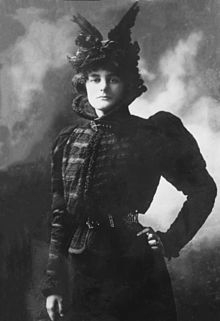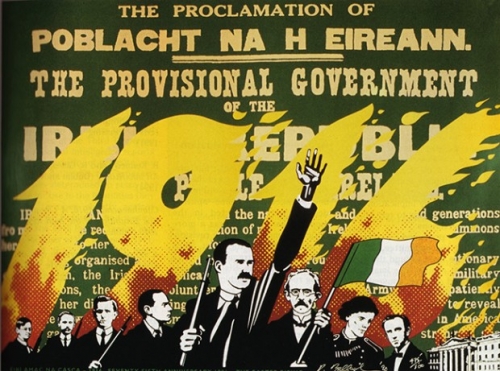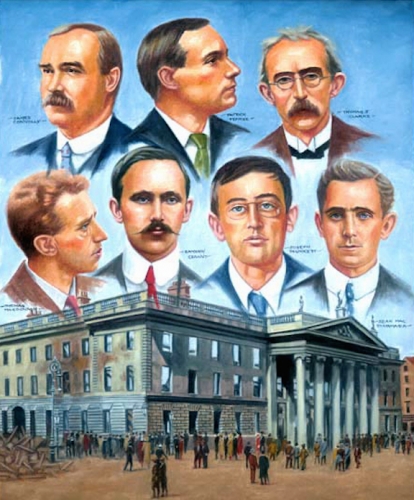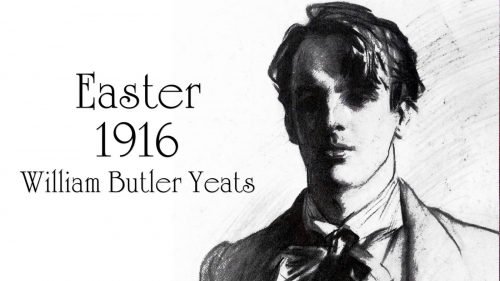William Butler Yeats is one of the poets that lived through the great social and geopolitical changes of the first World War. World War I was a major turning point in history for the United Kingdom as well as the world in general. During the war, Irish separatist saw an opportunity to rebel against Britain and gain independence. The uprising, termed the Easter Rising, occurred in 1916. Yeats, at this point in his life, was a well-known writer and playwright who supported the nationalist. However, to understand Yeats’ “Easter, 1916” a poem about the uprising we need to contextualize the author and the poem. The poem centers around the author’s conflicting emotions about the uprising. It identifies the events of everyday life against the sacrifice of everyday people for a broader national goal. Ultimately the poem dabbles in the identity politics of its day. Identity politics are important to the understanding of his poem “Easter, 1916” because they play an important part in how Yeats sees himself and the world around him.
The research includes analyses of Yeats life and his work. The unifying thread among the different essays is the importance of “Easter, 1916” and this epoch of the writer’s life. They also relate in hashing out how his earlier experiences led to his involvement and his perspective on the historical event of the Easter Rising. In works such as Katherine Kodani and Neville F. Newman we see how his early life and experiences shaped his later poetry, including “Easter, 1916.” In Marjorie Perloff and Seongho Yoon’s works, we narrow the focus down into how Yeats goes about to establishing the events of the poem in the context of his personal feelings towards the uprising. The encyclopedic and research for the National Library of Ireland give us the necessary historical context to understand the author and the poem’s place in history.
 At an early age Yeats became involved in mysticism which would prove controversial his whole life. Kodani explains, “The early poetry of William Butler Yeats was very much bound up with the forces and interests of his early years. Many of these influences — such as that of Maud Gonne, his father, and his own mystic studies — have been elucidated by some careful scholarship.” Yeats’ writing was influenced by his study of mysticism. He joined the Theosophical Society as his immediate family’s tradition was not very religious. Later he “became interested in esoteric philosophy, and in 1890 was initiated into the Hermetic Order of the Golden Dawn” (Seymour-Smith). He would pursue mystical philosophy the rest of his life to a greater or lesser degree.
At an early age Yeats became involved in mysticism which would prove controversial his whole life. Kodani explains, “The early poetry of William Butler Yeats was very much bound up with the forces and interests of his early years. Many of these influences — such as that of Maud Gonne, his father, and his own mystic studies — have been elucidated by some careful scholarship.” Yeats’ writing was influenced by his study of mysticism. He joined the Theosophical Society as his immediate family’s tradition was not very religious. Later he “became interested in esoteric philosophy, and in 1890 was initiated into the Hermetic Order of the Golden Dawn” (Seymour-Smith). He would pursue mystical philosophy the rest of his life to a greater or lesser degree.
Generally speaking, scholars have divided his professional life into three distinct periods. The first period consists of his time in London from1887 to around 1896. During this period Yeats worked and lived with other poets of his time. By 1896 he moved back to Ireland and worked as a playwright. This period is referred to as his more mature professional period. This would be the second period of his career. During the second period, he also became involved with Irish Nationalist. “He became established as one of the leaders of the Irish renaissance” (Seymour-Smith). This period of his professional life ended around the year 1909.
The final period of Yeats professional life starts in 1910 with his poem “The Green Helmet.” During the final stage of his career Yeats writes some of the poetry he terms occasional poems. Perloff states, “the occasional poems such as ‘Easter 1916,’ ‘A Prayer for my Daughter,’ ‘Coole Park, 1929,’ and ‘Parnell’s Funeral,’ that, rather than the more overly philosophical poems, constitute Yeats’s central achievement and are the cause o f his continuing popularity” (327). The onset of this period was a time of political turmoil in Ireland were Irish nationalist rose against the British. The National Library of Ireland explains on its website, “following the outbreak of the First World War in August 1914, the Irish Republican Brotherhood decided to stage an insurrection at the next opportune moment, bearing in mind the maxim of England’s difficulty being Ireland’s opportunity.”
The murder of James MacBride during the Easter Rising by the British was very troubling to him. This was the man who married Maude Gonne the woman Yeats had proposed marriage to in 1899. The events of the uprising clearly left a mark on Yeats as his later poetry and work would reflect. In fact, Perloff explains, “it is the interaction of public event and private experience, rather than its symbolic dimension or its political philosophy, that distinguishes a poem like “Easter 1916.” The fusion is, moreover, one that Yeats very nearly invented” (328).

As Perloff explains Yeats mixes the political with the personal. He intertwines public events with his own personal grieve. In this style, the poems reference not only his pain but also the pain of others around him.
Now that we have contextualized Yeats’ life, let us enter the arena of the poem “Easter, 1916.” As we noticed Yeats considered himself Irish and was involved in Irish politics. His experienced shaped his view of the greater United Kingdom and its policies towards its subjugated areas. In Yeats’ poem “Easter, 1916” we repeatedly find the theme of identity. The poem’s first line immediately establishes otherness. It states, “I have met them at close of day” (Yeats 1). He separates his identity from the identity of the people he meets and interacts with on a daily basis. He is aware that there must be interaction and communication but he feels above it. “I have passed with a nod of the head / Or polite meaningless words” (6,7). The small-talk of acquaintances or passerby does not interest him much.
The difference between them and the speaker is demarcated by the separation or removal of the place. The speaker does not place importance on the affairs of the others. Marjorie E. Howes states, “Yeats was a nationalist who longed for community but hated crowds” (66). This tongue-in-cheek compliment scratches the surface of the poetic image that “Easter, 1916” presents. The speaker acknowledges what is happening in his world and to some degree wants to be a part of it but at the same time feels he is above the people he encounters on a daily basis. He interacts with them, jokes with them, and nods at them “to please a companion” (Yeats 11). The poem establishes the general in order to establish the personal perspective of the speaker.
This memorable poem succeeds because it reaches the reader in an intimate way. Although, the poem was written in the midst of World War I and, in effect, is a poem about the side-effects of said war on the United Kingdom’s political system, Marjorie Perloff makes an interesting observation, “it does celebrate a particular event of a public character — in this case, a political crisis — but its tone is not that of the forum but, on the contrary, that of private meditation” (328). The poem focuses on the intimate and the personal. The observation of one speaker against the backdrop of a political rebellion. The events of the political crises fade to the background to allow the individual to share his own moral and personal growth.
The focus broadens after the first stanza to encompass the people in the speaker’s life. He touches upon the lives of women but mostly focuses on men and their sacrifices and the daily struggle that makes up life. He touches upon the intimate and the personal such as the arguments of marriage and the lust of days gone by, “what voice more sweet than hers / When, young and beautiful” (Yeats 21,22). He laments for the sacrifices and the loss of people he had dismissed in the first stanza. It is an interesting capitulation to the political will of the multitude. Neville F. Newman states, “the fundamental political changes represented by the Easter rebellion contain the potential for a political and moral petrification” (146, 147). Identity politics is a complex issue. By identifying and defining the otherness of people, in this case, the Irish who wanted liberty at the cost of human sacrifice, there is a clear pattern and path to follow. The poem wonders if that path is worth the undertaking and sacrifice.
The third stanza is the only one that does not end with the line “a terrible beauty is born” (Yeats 16, 31, 71). In this way and in others, it is different from the other stanzas in the poem. It focuses on the changing nature of the situation. It veers, fast-paced, into the moment of the confrontation. The speaker is forced into the action. Newman explains:

The ‘living stream’ that is troubled by the stone clearly is life itself. In a constant state of progression, the stream contains a force and purpose that drive without comprehension past everything it passes over, or which passes through it — unless, that is, the stream acknowledges the permanent reminder located ‘in the midst of all’ (145).
The speaker is forced to partake in the events around him. The events drive the speaker’s world forcefully forward and all he can do is observe live unfolding before him.
The final stanza again focuses on the personal. It is as if the speaker understands through the force of the preceding events the sacrifice of the people around him. He begs the question, “was it needless death after all? (Yeats 57). The crises the inspired this poem shook Yeats profoundly. He lost people he had for better or worse known and associated with intimately. The struggles and the sacrifices added up. Thus Yeats’ work “is a poem of experience, a dramatic lyric in which actual persons and places from the poet’s own life and from the public life of the Ireland that he knew become constituent parts of his drama” (Perloff 334). Therefore, “a terrible beauty is born” (Yeats 71). The sacrifices are terrible and the deaths tragic, but from the events of the 1916 uprising something is accomplished. The march towards Irish independence had not come to a conclusion but, as Yeats suggests with the last poignant line, the sacrifices will be remembered.
The uprising was a public and private event for Yeats. “Easter, 1916” reflects this duality. “At the heart of “Easter 1916” are the mixed feelings of respect and annoyance, grief and horror. Whereas it was hard for Yeats to deny the deep impact of the rising on his outlook, he could not help feeling perturbed by both the outbreak and aftermath of the Rising” (Yoon). From this conflict arises crises of identity politics throughout the poem. The public and personal impress upon each other and Yeats demonstrates how he cannot extricate himself from the events that are affecting his loved ones, friends, and acquaintances. The overarching themes of the poem are the normalcy of life under the British system and the price of change. The death and sacrifice that can bring about the end to the perceived injustice from British control is a heavy one. The author seems to be weighing the costs of the sacrifices and ultimately glorifying those sacrifices.





 del.icio.us
del.icio.us
 Digg
Digg